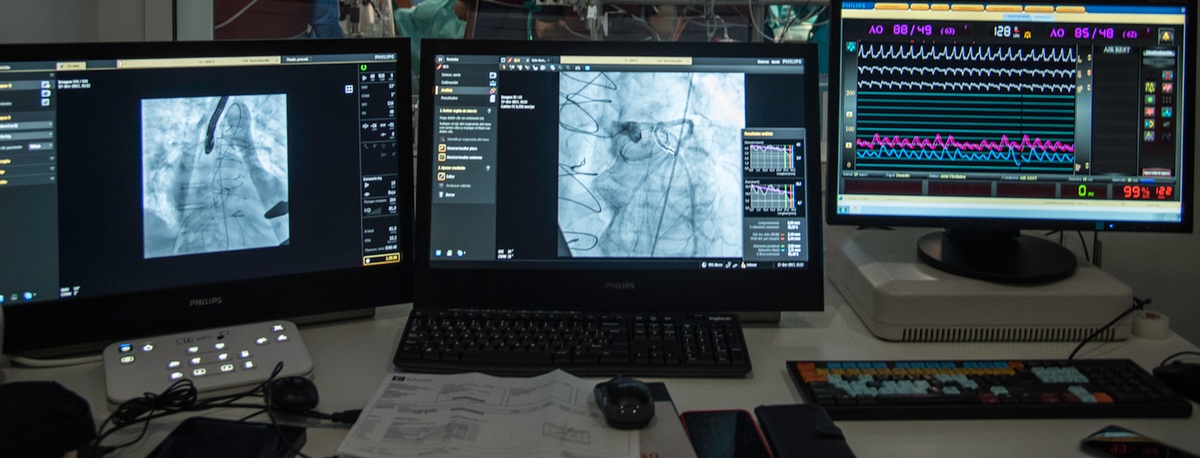

State-of-the-art technology
Hybrid operating room: at the forefront of medical innovationThe team at the Teknon Cardiovascular Institute is expert in using the most advanced technology for the most accurate and reliable diagnosis of heart conditions and their treatment. We have a state-of-the-art hybrid operating room that allows us to perform minimally invasive procedures with the utmost safety and promoting rapid patient recovery.
Differences between a hybrid operating room and a conventional operating room
Benefits for patients
Less aggression for the patient, faster recovery after surgery, and less risk of infections and post-operative complications. These three factors are making minimally invasive surgery the standard for current surgical procedures.
State-of-the-art haemodynamics rooms
Our goal is to offer the latest advances in cardiovascular disease treatment. We also have three haemodynamics and arrhythmia treatment rooms, each equipped with a state-of-the-art image-guided therapy platform. These platforms, with an intuitive interface similar to a tablet, allow complex procedures to be carried out in an app environment, working in parallel and scheduling large numbers of tasks in advance, which facilitates the work of professionals and increases patient safety.
Advanced diagnostic imaging techniques
The most notable diagnostics techniques available are 3D echocardiography, cardiac magnetic resonance imaging, cardiac and coronary CAT scans, and PET CT scans.
- 3D echocardiography (3DE/3D Echo) 3D transthoracic echocardiography (3D-TTE) and transoesophageal echocardiography (3D-TEE) are accredited reference techniques for screening patients with heart valve disease. A simple ultrasound technique, 3D echocardiography is remarkable or rendering readily comprehensible images, making it the most lucid means to assess the heart, and an invaluable for cardiologists and other specialists treating heart disease patients. The most common indications for performing a 3D Echo examinations are:
- Aortic valve assessment: stenosis and regurgitation.
- Assessment of degenerative mitral valve with closure faults (insufficiency): mitral valve prolapse is one of the most common indications for 3D echocardiography, although it can also be useful for assessing mitral stenosis, especially in cases with poor transthoracic window.
- Prosthesis assessment: this is another of the main indications for the 3D-TTE and 3D-TEE. In particular, the assessment of periprosthetic dehiscence. The information is more accurate than 2D Echo.
- Assessment of the left atrium and left ear.
- Study of congenital heart disease.
- Guide to percutaneous interventional procedures.
- Assessment of intracardiac tumour masses.
- Cardiac Magnetic Resonance Imaging. Centro Médico Teknon is one of the few private centres that currently has a cardiac magnetic resonance imaging (MRI) machine, a state-of-the-art technique for evaluating patients with heart disease, and the most advanced technology for performing this procedure (high-field MRI machine, specific antenna for cardiac studies, advanced image reconstruction software, and CD recording and colour image printing).
 Coronary Multidetector CT (MDCT). The 64-slice coronary MDTC is a novel technique for viewing heart arteries with no need to insert catheters. It is recommended in patients with chest pain under investigation who are at intermediate risk of coronary heart disease, have atypical chest pain, or have had stress tests with inconclusive results. It consists of a helical scanner with high-speed rotation that allows images of the heart in motion to be acquired while the patient is moved inside the scanner.
Coronary Multidetector CT (MDCT). The 64-slice coronary MDTC is a novel technique for viewing heart arteries with no need to insert catheters. It is recommended in patients with chest pain under investigation who are at intermediate risk of coronary heart disease, have atypical chest pain, or have had stress tests with inconclusive results. It consists of a helical scanner with high-speed rotation that allows images of the heart in motion to be acquired while the patient is moved inside the scanner.
Teknon also has a new-generation computed tomography scanner that can obtain an image of the heart in a quarter of a second, the time it takes for a single heartbeat, and can acquire images with very low doses of radiation, up to 82% less.
Computed Axial Tomography (CAT) angiography techniques are also essential in the study of the aortic valve, aorta, and peripheral arteries in patients who will undergo a transcatheter aortic valve implantation (TAVI) procedure without the need for surgery.- PET-CT. PET-CT systems provide a combination of metabolic information from PET (Positron Emission Tomography) images and morphological information from CT (Computed Tomography) images in a single scan. The images of the human body obtained using this technique are used to assess various diseases, including heart disease. It allows the blood flow to the heart to be determined and signs of coronary disease to be assessed. It is used to determine areas of reduced function that are alive and scar tissue caused by a previous heart attack. Together with myocardial perfusion imaging, PET scans can differentiate between non-functional heart muscle and viable heart muscle that could benefit from a procedure such as angioplasty or coronary bypass surgery to restore blood flow and improve heart function. It is also very useful in diagnosing infections of cardiac structures and valve prostheses.
Our team is at your complete disposal.
![]() Centro Médico Teknon
Centro Médico Teknon
Carrer de Vilana, 12, 08022 Barcelona
![]() Opening hours
Opening hours
Open 24 hours
![]() Phone Numbers
Phone Numbers
932 906 200
900 301 013


































